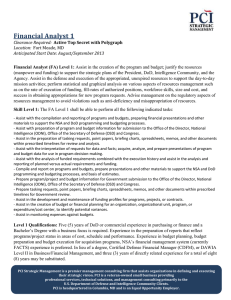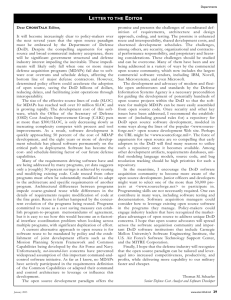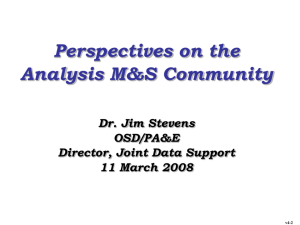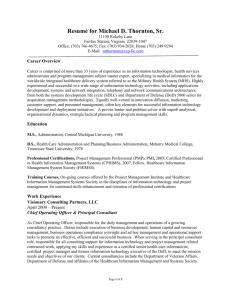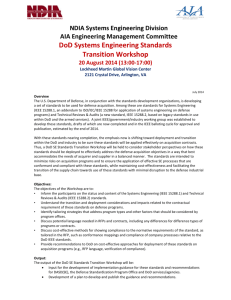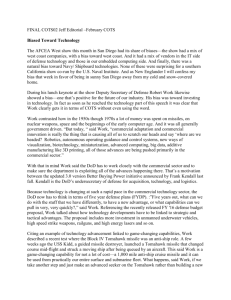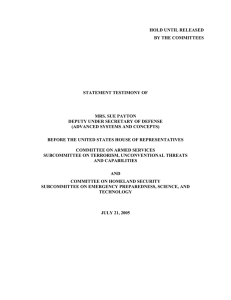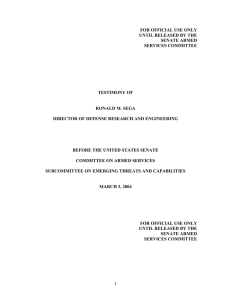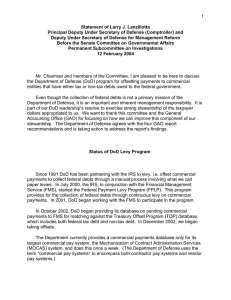DAY 2 Role of PA&E Kathleen Conley
advertisement
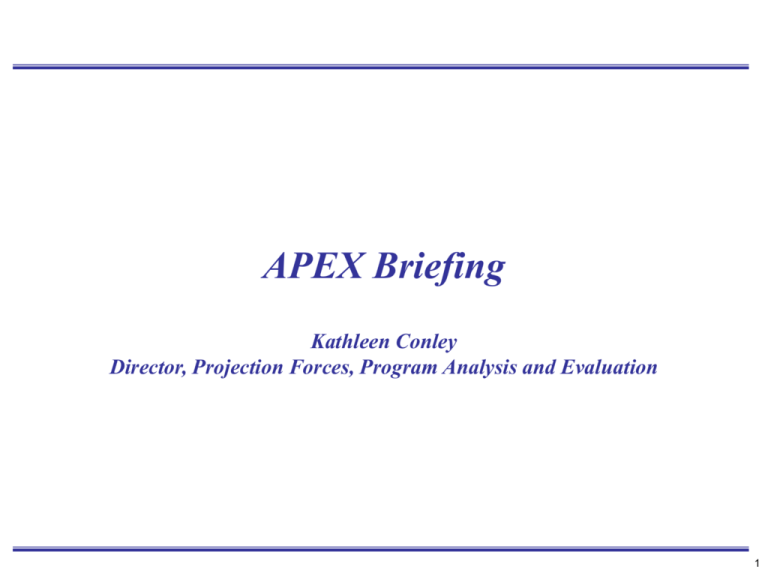
APEX Briefing Kathleen Conley Director, Projection Forces, Program Analysis and Evaluation 1 Outline • Economic Outlook • Transforming • Current Analytic Efforts 2 U.S. Defense Priorities Defending America Today and Tomorrow • Deter potential adversaries and defend America and American interests • Counter asymmetric threats • Fight and win the global war on terror • Assure readiness of the Armed Forces • Mitigate surprise • Ensure U.S. leadership role in the world • Transform the Department of Defense – Reshaping military capability for the 21st Century – Changing culture, business practices, processes and organizations for sustained advantage 3 Compelling Need for Change The World Has Changed • This is a period of significant, discontinuous change with great uncertainty: – – – – – – – Globalization Accelerating rate of technological change Information age Homeland security Non-State as well as state actors Asymmetric as well as conventional threats Unrestricted by conventional rules • Falling barriers to competitive entry – Access to highly capable, low-cost and rapidly changing technologies – Access to capabilities in key domains – space, sea, cyberspace • Failure to transform risks losing our competitive advantage Those who do not see the need to change are often those who need it the most. 4 Federal Spending by Category as a Percentage of GDP 25% Net Interest 15% Mandatory 10% Non-Defense Discretionary 5% Defense Discretionary 2008 2006 2004 2002 2000 1998 1996 1994 1992 1990 1988 1986 1984 1982 1980 1978 1976 1974 1972 1970 1968 1966 1964 0% 1962 Percentage of GDP 20% 5 Budget Deficit Remains Difficult Challenge U.S. Unified Federal Budget Surplus/Deficit Projections 2004-2014 200 CBO January 2005 100 0 -100 Then Year $Billions CBO September 2004 -200 OMB July 2004 -300 OMB February 2005 -400 -500 -600 White House January 2005 CBO January 2005 + No Sunset on Tax Cuts + AMT Reform + Discretionary Spending Growth at Rate of Nominal GDP Growth + 6 years of OEF & OIF then phased out -700 -800 2004 2005 2006 2007 2008 2009 2010 2011 2012 2013 2014 Calendar Year 6 $500 $400 $400 $300 $300 TY$B $500 ACTUAL Carter Reagan I Reagan II G. Bush Clinton I Clinton II Fiscal Year President during Budget Submission G. W. Bush I 2009 2008 2007 2006 2005 2004 2003 2002 2001 2000 1999 1998 1997 1996 1995 1994 1993 1992 1991 1990 1989 1988 1987 1986 1985 1984 $100 1983 $100 1982 $200 1981 $200 1980 TY$B President's Budget FYDP Projections vs. Actual Defense Budget G. W. Bush II 7 FOUO Personnel Costs* vs. DoD Topline $500 $400 Then Year $ Billions DoD Topline $300 $200 Contracts for Services** Military Benefits*** $100 MilPers CivPay $0 1963 1973 1983 * Source: OUSD(C) and WHS, excludes costs not on the DoD budget (e.g., VA) ** Source: WHS, which categorizes contracts as Procurement, RDT&E, or Services *** Retirement, DHP, Family Housing FOUO 1993 2003 8 FOUO Personnel Costs* vs. DoD Topline 100% $1,000 Constant $ Topline (right axis) 75% $750 % of DoD Topline Contracts for Services** 50% $500 Military Benefits*** 25% Constant $ Billions (Base FY05) 67% $250 MilPers CivPay 0% 1963 1973 1983 * Source: OUSD(C) and WHS, excludes costs not on the DoD budget (e.g., VA) ** Source: WHS, which categorizes contracts as Procurement, RDT&E, or Services *** Retirement, DHP, Family Housing FOUO 1993 $0 2003 9 DoD Budget Authority by Appropriations Title $200 $200 $180 $180 Military Personnel $160 Operations and Maintenance $140 $140 $120 $120 $100 $100 $80 $80 Procurement $60 $60 $40 $40 $20 $20 R,D,T&E 2009 2007 2005 2003 2001 1999 1997 1995 1993 1991 1989 1987 1985 1983 1981 1979 1977 1975 1973 1971 1969 1967 1965 1963 1961 1959 1957 1955 1953 1951 1949 $0 1947 $0 1945 Constant FY 2005 $Billions $160 10 Transformation Principles • Culture – – – – Balanced risk taking Innovation Superior speed Joint information, content and awareness • Operations – – – – Adaptive Joint and combined Tailored to specific need Use all elements of national power – Information driven • Business Practice, Process and Organization – Streamlined – Greater flexibility – Timely, decision-quality information – Integrating processes – Reduced cycle times • Systems and Capabilities – – – Integrated Networked systems Faster to the point of need • Precision effects Improvement needed in all areas to strengthen joint and integrated performance 11 The Overall Framework for Change Historical World View Future Objectives Central Planning To Adaptive and Dynamic Planning Fixed, Predictable Threat To Capabilities Against Shifting Threats Mature Business and Organization To Mix of New and Mature Organizations Inputs Based Management – Focus on Programs To Output Based Management – Focus on Results Appropriated Funds – “Cost is Free” To More Market-like and price based Segmented Information – Closed Architecture To Networked Information – Open Architectures Stovepiped and Competitive Organizations – “Zero sum Enterprise” To Aligned Organizations with common and shared objectives 12 Historical World View Central Planning Future Objectives Developing Tools Adaptive and Dynamic Planning Changes to War Planning and Support Tools Capabilities Against Shifting Threats Capabilities Based Planning Joint Operational Concepts New Modeling Approaches Mix of New and Mature Organizations SJTF, UCP realignment, OSD changes Inputs Based Management – Focus on Programs Output Based Management Focus on Results Global Force Management Balanced Risk Scorecard Metrics Appropriated Funds – “Cost is Free” More Market-like and price based Offsets Required Portfolio Thinking Segmented Information Closed Architecture Networked Information – Open Architectures Horizontal Integration GIG Standards BMMP Aligned Organizations with common and shared objectives Capabilities Equivalencies Global Force Management Integrating Processes/JCIDS Fixed, Predictable Threat Mature Business and Organization Stovepiped and Competitive Organizations – “Zero sum Enterprise” Integrating Processes Planning, Programming & Budgeting System Strategic Planning Requirements Acquisition 14 What Is the Purpose of PPBE? • Provide Civilian Control and Strategic Direction – Centralizes decisionmaking in the Office of the Secretary of Defense – Manages allocation of resources to meet the Secretary’s goals • Create a joint (DoD-wide) program – Integrates individual components’ inputs into a single defense program – Ensures stakeholders have a voice; builds consensus • Provide financial “checks and balances” – Promotes efficient and effective allocation of funds – Ensures the cost of defense programs are realistic / affordable • Provide basis for justifying programs and budgets to the White House and Congress PPBE is the principal tool used by the Secretary and the Deputy Secretary in managing the Department of Defense 15 The PPBS: Six Principles • Decisions should be based on explicit criteria of national interest, not on compromises among institutional forces. • Requirements and costs must be considered simultaneously. • Major decisions should be made by choices among explicit, balanced, feasible alternatives. • The Secretary should have an active analytic staff to provide him with relevant data and unbiased perspectives. • Open and explicit analysis, available to all parties, must form the basis for major decisions. • A multiyear force and financial plan is required to project the consequences of present decisions into the future. 16 5 Principles of PA&E • PA&E will provide independent and objective analysis. • PA&E’s analyses and advice will be fact based. • PA&E is committed to open thinking. • PA&E is people-centered. We treat people fairly and respectfully. • PA&E operates in an environment of trust and confidence. 17 Analytic Agenda • Department-wide agreement to make major, joint analysis efforts more effective, efficient, relevant • Building blocks include: – National Security Strategy and other strategic and planning guidance – Scenarios and Data (Defense Planning Scenarios and MultiService Force Deployment) – Studies and Wargames (e.g., OA-03, OA-04, OA-05, and MCS) – Results in a package comprising a scenario, concept of operations, and integrated data used by DoD Components as a foundation for strategic analysis (called an analytical baseline) • Highly collaborative and transparent: OSD, JS, Agencies, Services, and CoComs participate 18 PA&E Proposals for Ongoing Analysis* • • • • • • • • • • • • • • • • • Joint Air Dominance Ground Forces Capabilities Future Combat System and Army Modularity Medical Readiness Review and Health Care Benefit Costs Compensation Review Supply Chain Management Manpower Submission Process Space Industrial Base Future Strategic Forces Airborne/Area Moving Target Indication/Indicator (AMTI) and Ground Moving Target Indication/Indicator (GMTI) Tradeoffs Airborne Intelligence, Surveillance, and Reconnaissance (ISR) Communications Persistent ISR Net Centric Ops MILSATCOM Capabilities Mobility Capabilities Study Aerial Refueling Tactical Airlift and & Aerial Refueling *Subject to guidance from IPT heads 19 Biggest Challenges • • • • • Facts and Transparency Linking Strategy, Plans, Resources and Execution Raising decision level to capability and portfolio Balancing Risk Developing, Aligning and Motivating Talent 20 PA&E Organizational Chart DIRECTOR PROGRAM ANALYSIS & EVALUATION PRINCIPAL DEPUTY DIRECTOR Brad Berkson VADM Stanley R. Szemborski, USN DEPUTY DIRECTOR (STRATEGIC AND SPACE PROGRAMS) DEPUTY DIRECTOR (THEATER ASSESSMENTS AND PLANNING) DEPUTY DIRECTOR (GENERAL PURPOSE PROGRAMS) DEPUTY DIRECTOR (RESOURCE ANALYSIS) Michael L. Ioffredo Eric J. Coulter James L. Johnson Richard P. Burke Intelligence, Surveillance, and Reconnaissance Programs Division Study and Analytical Support Division Force Planning Division James N. Bexfield, Director Joseph R. Nogueira, Director Matthew Schaffer , Director C4 and Information Programs Division Economic and Manpower Analysis Division Jerome E. Pannullo, Director Joint Data Support Office Land Forces Division James G. Stevens, Director Mark F. Cancian, Director Force and Infrastructure Cost Analysis Division Krystyna M. Kolesar, Director Scott A. Comes, Director Joint Warfare Systems Office Naval Forces Division Strategic Defensive and Space Programs Division Dennis K. Evans, Director Charles P. Werchado, Director Steven R. Miller, Director Simulation Analysis Center Al Sweetser, Director Resource Management & Operations Division Janet S. Felts, Director Operations Analysis and Procurement Planning Division Tactical Air Forces Division Programming and Fiscal Economics Division James L. Johnson (Acting) Projection Forces Division Teresa W. Gerton, Director Kathleen M. Conley, Director Weapon Systems Cost Analysis Division Steven R. Miller (Acting) Regional Assessment and Modeling Division Timothy E. Bright, Director 21

